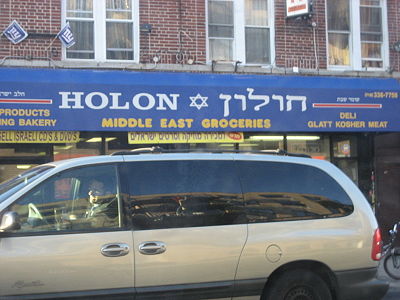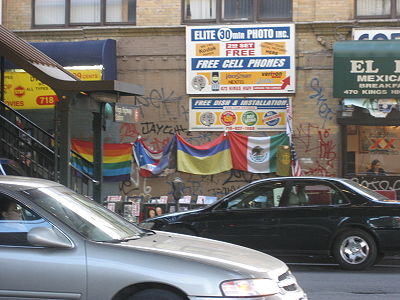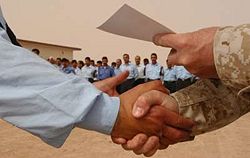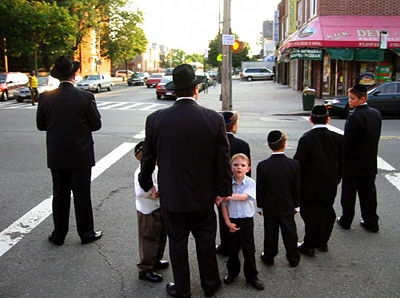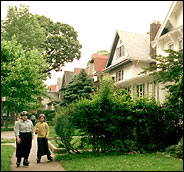Views
There is a mosque followed by a yeshiva, only a five-minute walk away. Look at the Mexican worker making kosher sushi! Orthodox Jewish men wearing yarmulkes share the sidewalks and store aisles with veiled Muslim women. Muslim, Jewish, and other teenagers get together once a week to play ball in the basketball court. Nearby, a sign outside a barbershop proclaims: “We speak English, Russian, Urdu and Yiddish.” A Muslim grocer on Avenue I boasts that a third of his goods are kosher.
WELCOME TO THE NEIGHBORHOOD OF MIDWOOD!
The area of Midwood boasts vibrant racial diversity, with an established Orthodox and burgeoning Sephardic Jewish population, as well as new immigrants from the former Soviet Union, Pakistan, and India. Here we focus specifically on the intergroup relations between the Jews and Muslims (mostly from Pakistan) of Midwood, as well as Jews within their own communities.
The Muslims and Jews of Midwood: A Peaceful Coexistence in Brooklyn Between Two Groups Who Can't Seem To Get Along on the Other Side of the World
For over 20 years, both the Jews and Muslims of Midwood have lived together simultaneously in the same neighborhood, in relative peace. In Midwood, both of these groups live closer together than in almost any other place in the country. In fact, it was the presence of observant Jews that brought Pakistani Muslims to Midwood in the early 1980s. When their numbers were few and there were no ritual, or halal, butchers to slaughter meat according to their strict dietary code, the Pakistanis turned to the kosher butchers of Midwood. Both the Jews and Muslims are united on the issue of pork, which is forbidden in both of their religions, and so members from both religious groups often share the same butchers and shop in the same supermarkets.
Admittedly, the community is sometimes tense, but through work and dedication, it has, on the whole, remained productive and peaceful. When unrest in the Middle East first began, Jewish and Muslim leaders in Midwood took immediate action to keep the violence in the Middle East from spilling into their own neighborhood. They held a meeting, which led to several more, and eventually the process grew into a series of ongoing joint projects, from educational outreach to health care initiatives.
When strife did arrive at New York’s shores on September 11th, the community responded by intensifying the outreach between followers of its two faiths, thus strengthening the relationship between both groups. As Rabbi Kaplan said, "We were going to war with a lot of people who looked like folks in our community. We were afraid it was going to play out here. … We wanted to make a statement. We all don't agree on what's happening in the Middle East, but we agreed we want to live together in Brooklyn." Rabbi Kaplan joined forces with Muslim activist, Mohammad Ravi, now director of the Council of People's Organizations (COPO), to institute change and reform during the aftermath of the 9/11 tragedy. For teenagers, these two leaders set up "Youth Bridge-NY," in which teens from different communities, ethnic, racial, and religious backgrounds work together to develop leadership skills. They raised supplies for the victims of the tsunami, the Pakistani earthquake, and hurricane Katrina. Each year, they organize a walk for peace through Brooklyn - the banner that leads the several hundred people as they walk from synagogues to mosques reads: "The Children of Abraham ... Walk for Peace."
After September 11, Jews were also encouraged to visit mosques, and Muslims were invited to drop by nearby synagogues. As Mr. Almontaser, a Muslim man in the neighborhood, said, “We pull together on the things that concern us here. We don’t try to change ideas and perspectives.” This is what allows Jews and Muslims to coexist so peacefully in Midwood. Osher Tanami, 36, a teacher at Yeshiva of Flatbush, offered a Talmudic response when asked why the Jews and Muslims of Midwood are able to get along so well. Her response- "Why not?"
However, it would be false to state that there has been no periodic intergroup conflict between the Jews and Muslims of Midwood. On the night of October 29, 2007, for instance, the stable relationship between the Jews and the Pakistani Muslims was threatened because of a racist attack. "A group of Jewish teenager approached Shahid Amber, a 24-year-old Pakistani, and hurled ethnic slurs at him, calling him a “terrorist”, before proceeding to pummel him with kicks and punches sharpened by brass knuckles.” In the end, the shared bond between the Jews and Muslim proved to be stronger and more powerful than any differences that separate the groups, thus re-establishing peaceful relations between Midwood's Jewish and Muslim population.
Indeed, many Jews and Muslims who live in Midwood hope that their success can provide a model for a workable peace in the Middle East. During these days of polarization and isolation between Muslims and Jews in the Middle East, perhaps Midwood could be leveraged as an example of what is possible.
"My spiritual path informs who I am, and just because we form these coalitions it doesn't mean I have to become like you, or you like me, but we do have to work together to make a better world." –Rabbi Kaplan to a Mohammad Ravi, a Muslim activist in the community
Relations Between the Jews of Midwood Within Their Own Communities
The Jewish community has always been categorized into two different groups: Ashkenazi and Sephardic. These two groups represent the different backgrounds of diverse Jews in today’s world. Ashkenazi Jews generally come from Eastern European decent, while Sephardic Jews generally come from North African, Spanish and Middle Eastern decent. Over time, these two groups have established different customs, views, traditions, and lifestyles representative of their cultural origins. While they differ in certain ways, they also maintain many ties within the different communities in which they reside.
Midwood is one of the many neighborhoods that is home to both Sephardic and Ashkenazi Jews. Both of these groups share a common religious bond. A primary example of the very close bond that exists between these groups is the East Midwood Jewish Center. The Jewish Center is joined together with Sephardic, Ashkenazi, Orthodox, Reform, and Hasidic organizations to constitute one of the largest, most vibrant and beautiful Jewish communities in the world. The East Midwood Jewish Center regularly holds events such as An Evening of Sephardic/Ladino Music, which show what a group of Ashkenazi Jews can do with the musical legacy of their Sephardic brethren. Not only do they share a common Jewish Center, but the Ashkenazi and the Sephardic Jews also eat at the same restaurants, and the women even often go to the same mikvahs (ritual baths). Food is another one of the many things that connects the Ashkenazi and Sephardic Jews. Both groups shop in the same supermarkets, following the same guidelines in deciding what foods are and are not Kosher. The entire Jewish community of Midwood lives together like a band of brothers.
However, though the Sephardic and Ashkenazi Jews are linked together by a similar way of life, numerous differences exist among them as well. Sephardic and Ashkenazi Jews attend different synagogues, follow different Rabbis, pray from different texts in the siddur (a daily prayer book), and have different codes of dress. Sephardic Jews also have their own schools. The Yeshiva of Flatbush, for example, used to be a school for both groups of Jews. But now, almost 80% of the incoming class of freshmen is expected to solely consist of Sephardic Jews.
Very seldom do Sephardic Jews marry Ashkenazi Jews. Sephardic women generally marry at a very young age, and it is not uncommon for the husband to be ten or more years older than his wife. The divides between the different groups of Jews in Midwood are so apparent that Ashkenazi and Sephardic Jews even vacation in different places. The Ashkenazi Jews typically vacation in the country, in Upstate New York, while Sephardic Jews vacation in the beautiful Jersey shore of Deal, a borough in Monmouth County.
The most prominent Sephardic group residing in Brooklyn, however, is the Syrian community. The Syrian community is a tight-knit group, whose members refer to themselves as the "SY's." Although they interact and work together with other ethnic groups residing in Midwood, the SY's are generally much less accepting toward outsiders. They tend to stick to their own people, their own synagogues, their own ritual baths, and their own celebrations. If one attends a Syrian wedding, for example, it is most likely held in Sha'are Zion, which is the Syrian synagogue located on Ocean Parkway, and he/she will most likely find the entire Syrian community of Brooklyn at the event sometime throughout the night. The Sephardic Syrian community is also known to be wealthier than the Ashkenazi community of Midwood, acquiring its wealth from sources found all over the world.
Nonetheless, the relationship of common links, as well as separations, that exists between the Sephardic and Ashkenazi communities of Midwood, Brooklyn contributes to the distinctiveness and beauty of this unique neighborhood.
